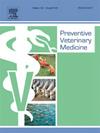Evaluating slaughterhouse findings for lung and tail lesions in fattening pigs from secondary data
IF 2.2
2区 农林科学
Q1 VETERINARY SCIENCES
引用次数: 0
Abstract
Using slaughterhouse findings to monitor animal health and welfare is not a new idea. The German Federal Veterinary Surgeon’s Association even calls for the establishment of an animal health database that combines slaughterhouse findings with health and farm data from already existing monitoring programs to create a comprehensive monitoring and surveillance tool. In an attempt to combine secondary health data from slaughterhouse findings, antibiotic use monitoring as well as biosecurity and husbandry evaluations into an integrated dataset, data from 18,593 fattening pig farms across Germany participating in the private sector Quality scheme for food (from 2018 to 2020) were harmonized at the half-year level and combined. As an example, the combined data was used to evaluate lung and tail lesion findings from abattoirs as indicators of animal health and welfare with descriptive analysis and mixed model approaches. Differences between abattoirs due to different data collection methods were taken into account by either considering the abattoir as a random effect or standardizing the prevalence data using abattoir means. The mean prevalence of lung lesions per half-year varied between 8.69 % and 9.78 %. The mean prevalence of tail lesion increased continuously from 0.65 % in the first half of 2018–1.04 % in the second half of 2020. Farm size, agricultural region, half-year and antibiotic treatment frequency were found to be associated (p < 0.000001) with the prevalence of both lung and tail lesions. A lack of variance and specificity of the secondary biosecurity and husbandry evaluation data restricts the use of individual assessment criteria as well as biosecurity and husbandry indices (calculated from a subset of assessment criteria) in our analyses. We therefore used the data for a broad categorization of farms and it could be found, that the occurrence of a lower rating in any assessment criteria during farm evaluations is associated (p < 0.000001) with a higher prevalence of lung and tail lesions, but the interpretation remains uncertain. The already existing data in the fattening pig sector can be used for the evaluation of animal health and welfare indicators to a large extent. Nonetheless, missing information, differences and changes (over time) in data collection methods introduce biases into the dataset. By improving the data quality and harmonizing collection methods, secondary animal health data could prove to be a useful tool in promoting animal health and welfare.
从二次数据评估肥猪的肺和尾巴损伤的屠宰场结果
利用屠宰场的调查结果来监测动物的健康和福利并不是一个新想法。德国联邦兽医协会甚至呼吁建立一个动物健康数据库,将屠宰场的调查结果与现有监测项目的健康和农场数据结合起来,创建一个全面的监测和监督工具。为了将来自屠宰场调查结果、抗生素使用监测以及生物安全和畜牧业评估的二级健康数据整合到一个综合数据集中,参与私营部门食品质量计划(2018年至2020年)的德国18593个育肥猪场的数据在半年水平上进行了协调和合并。例如,利用描述性分析和混合模型方法,将综合数据用于评估屠宰场的肺部和尾部病变结果,作为动物健康和福利的指标。考虑到由于不同数据收集方法而导致的屠宰场之间的差异,要么将屠宰场视为随机效应,要么使用屠宰场均值对流行数据进行标准化。每半年肺部病变的平均患病率在8.69 %和9.78 %之间变化。尾病变平均患病率从2018年上半年的0.65 %持续上升至2020年下半年的1.04 %。发现猪场规模、农业地区、半年和抗生素治疗频率与肺部和尾部病变的患病率相关(p <; 0.000001)。二级生物安全和畜牧业评价数据缺乏差异性和特异性,限制了个体评价标准以及生物安全和畜牧业指标(从评价标准子集计算)在我们分析中的使用。因此,我们使用数据对农场进行了广泛的分类,可以发现,在农场评估期间,任何评估标准中评分较低的情况(p <; 0.000001)与较高的肺部和尾部病变患病率相关,但解释仍然不确定。育肥猪行业已有的数据在很大程度上可用于动物健康福利指标的评价。尽管如此,数据收集方法中的信息缺失、差异和变化(随着时间的推移)会给数据集带来偏差。通过改进数据质量和统一收集方法,二级动物卫生数据可被证明是促进动物健康和福利的有用工具。
本文章由计算机程序翻译,如有差异,请以英文原文为准。
求助全文
约1分钟内获得全文
求助全文
来源期刊

Preventive veterinary medicine
农林科学-兽医学
CiteScore
5.60
自引率
7.70%
发文量
184
审稿时长
3 months
期刊介绍:
Preventive Veterinary Medicine is one of the leading international resources for scientific reports on animal health programs and preventive veterinary medicine. The journal follows the guidelines for standardizing and strengthening the reporting of biomedical research which are available from the CONSORT, MOOSE, PRISMA, REFLECT, STARD, and STROBE statements. The journal focuses on:
Epidemiology of health events relevant to domestic and wild animals;
Economic impacts of epidemic and endemic animal and zoonotic diseases;
Latest methods and approaches in veterinary epidemiology;
Disease and infection control or eradication measures;
The "One Health" concept and the relationships between veterinary medicine, human health, animal-production systems, and the environment;
Development of new techniques in surveillance systems and diagnosis;
Evaluation and control of diseases in animal populations.
 求助内容:
求助内容: 应助结果提醒方式:
应助结果提醒方式:


